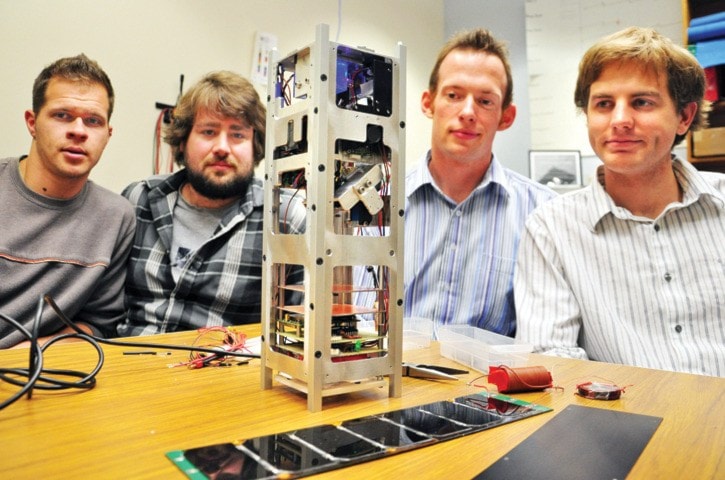A blue glowing laser light draws the eye to mechanical gizmos and circuit boards, all crammed into a rectangular metal frame about the size of a loaf of bread.
This small, humble device is the University of Victoria’s first shot at designing and building a micro-satellite. If the university had a space engineering program, this would be its Sputnik.
But this project was completed by small group of driven electrical engineering students who worked in their spare time to complete the UVic ECOSat project, the school’s entry into the Canadian Satellite Design Challenge.
Originally a competition involving 12 universities, the UVic crew made the final round of three in Ottawa in September, a brilliant accomplishment for an underdog team with little funding, few resources and originally, scant knowledge of satellite design.
“When we started in January 2011, none of us knew anything about aerospace or space,” admits Justin Curran, 26, chief engineer of the ECOSat project. “We came in 100 per cent cold.”
Each university team had a goal to build a “3U” cube satellite – 10 by 10 by 33 centimetres, weighing about four kilograms – housing a payload of real experiments, and wired to receive and transmit data, generate its own juice from solar panels and tough enough to be punted from a rocket carrying a large satellite into orbit.
The UVic group quickly found out that DIY satellite building doesn't exist. In an age where seemingly anything can be found online, the ECOSat team said there’s not much out there to help guide the construction of a device that can stand the rigours of near-earth orbit, about 900 kilometres up.
The team would cold-call engineers at companies such as McDonald Detwiller and Associates, a Vancouver-based technology company that designs satellites. “You work in a vacuum. No one tells you how to do it. It’s a lot of trial and error,” said Dan Kennedy, 24, one of the ECOSat engineers.
The project had a $25,000 budget, which helped pay for a co-op student, materials and industrial grade circuit boards, as opposed to notoriously expensive space-grade electronics, which have already been subjected to radiation. They also needed to account for how materials react in space – Kennedy points out that zinc, for one, turns to a gas in a vacuum.
Although led by small core group, about 100 engineering students came and went from the project, all learning and contributing to different subsystems of the ECOSat. Keeping track of bits of information gleaned from physics professors and aerospace engineers proved to be a daunting task.
“Overall we did a good job with budget we had. We had three payload changes, and changes on how the satellite was configured. Nine months ago everything was thrown out and we started from scratch,” Curran said.
“A few times I said this whole thing is a waste of time. It’s extremely hard but it’s doable. You just need the right people who are dedicated and willing to sacrifice.”
Key to the entire venture was finding experiments that could fit within the chassis, and wouldn’t overload other electronics. Fortunately for the team, recently graduated UVic electrical engineer Shayne Casavant, 26, works for Esquimalt-based AGO Environmental Electronics, which donated the experiment equipment and rescued the project.
All the payload experimental components centre around what is called the di-magnetic properties of pyrolitic graphite. Had the ECOSat been launched into space, the remarkably novel experiments would measure how pyrolitic graphite shields components from radiation and how it could be used to control the orbit of a satellite, among other properties.
“Controlling guidance only by magnetics has never been done before,” Casavant said. “The idea is to use it for a drive system in micro-gravity. With no gravity, even with a little force you’ll get high acceleration.
“It’s hard to see, but it can be tough to make these things work. You change one thing and it cascades through the payload,” he adds. “We did what we set out to do, which was provide functioning payload. We’re very happy with that accomplishment.”
Concordia University won the first round of the satellite challenge, and has a chance that its device will be launched into orbit. The UVic team expects to submit an improved design in a few years to a second round of competition, although it will need a new generation of students to take over.
“We’ve worked out a lot of kinks. The next one will be space-ready,” Kennedy says.
“We’ve got two years to find new kids to pick up where we left off,” notes Justin Saukarookoff, 24, who worked as a co-op student on ECOSat. “Anyone out there entering university in a year or two, this is a good point to join the club.”
See csdc.uvic.ca for more on the ECOSat project.
editor@saanichnews.com
